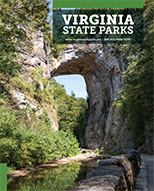Read Our Blogs
Black History Month: A Park's Legacy in Black History
Contributors to this article were Anne Reeder, Park Manager Holliday Lake State Park, Lee Wilcox, Chief Ranger Sailor’s Creek Battlefield Historical State Park, and Chris Calkins, Park Manager Sailor’s Creek Battlefield Historical State Park.
Virginia State Parks is home to a park whose black history dates back to the depression era and the civil rights movement of the 50s. During the early years of the Depression, the state began expanding the forest area buying land under the Resettlement Administration Program. A Civilian Conservation Corps camp known as Camp Gallion was established in June 1933. The camp was the headquarters for the 1390th CCC Company, one of the few African-American CCC groups in the state. Although the primary duty of the CCC workers was to build fire trails, the 1390th Company was credited with a number of other construction projects including the construction of the two dams that created Goodwin Lake and Prince Edward Lake recreation areas.

Camp Gallion was one of the few African-American Civilian Conservation Corps in the state.
According to local historian Greg Eanes the African-American CCC served as a pioneer in education, traditional and vocational, and offered many enrollees their first opportunities to learn skills that prepared young men for life. The Camp Gallion library had over 600 books, four daily newspapers, two weekly newspapers and one monthly. There was a camp newspaper, The Camp Gallion Dispatch, from 1935 to 1939.

African-American CCC offered opportunities to learn skills that prepared young men for life.
From its inception in 1936 until 1950, the Virginia State Parks system made no accommodations for persons of African-American descent. In 1948, during an era of racial segregation in the South, an African-American named Maceo Conrad Martin was denied admission to Staunton River State Park. Represented by legendary civil rights attorney Oliver W. Hill, Sr., Martin filed suit challenging Virginia’s policy of providing state parks only for whites; the suit sought to establish “separate but equal” facilities for blacks.

Park Superintendent Mr. Latham managed Prince Edward State Park for Negroes.
This legal challenge led to a decision by the Virginia Department of Conservation and Development to expand facilities at an existing recreation area for African-Americans in Prince Edward County and turn it into a full fledged state park. In January 1949, Governor William Tuck wrote a special appropriation totaling $195,000 for development of the new Prince Edward State Park for Negroes. Improvements undertaken at this time included the construction of an enlarged swimming area, expanded parking lots, new roads, six housekeeping cabins, a bathhouse, and a concession area. The new park was opened to the public in June 1950, making it Virginia's eighth state park and the only pre-Civil Rights Era state park for African-Americans.

Prince Edward State Park for Negroes was home to six housekeeping cabins.
As the park was developed in 1950, it was the only state park for African-Americans in the Commonwealth of Virginia. The two parks, Goodwin Lake and Prince Edward Lake, were run as two racially segregated parks until the early 1960s. Even though the Civil Rights Act of 1964 ended segregation, Prince Edward State Park and nearby Goodwin Lake Recreational Area continued to operate separately until they merged in 1976. As a result, Prince Edward-Goodwin Lake State Park was renamed Twin Lakes State Park in 1986.

Park visitors enjoyed a large swimming area and concession on the
banks of Prince Edward Lake.
Twin Lakes State Park is located near Farmville, about an hour southwest of Richmond. To get there, take U.S. 360 West of Burkeville to Route 613. Then go east on Route 629.
Drive Time: Northern Virginia, three to four hours; Richmond, one to one and a half hours; Tidewater/ Norfolk/ Virginia Beach, two and a half to three hours; Roanoke, three hours.
If you have read the article and have a question, please email nancy.heltman@dcr.virginia.gov.














